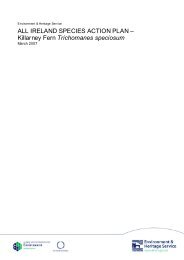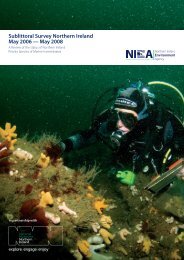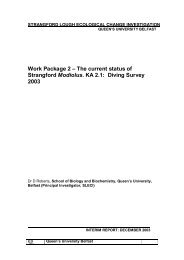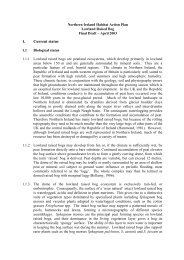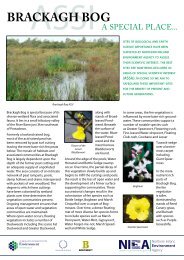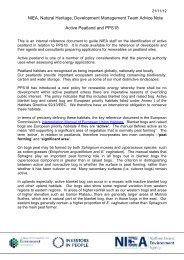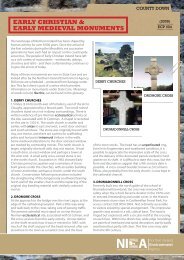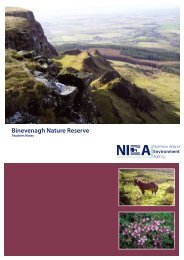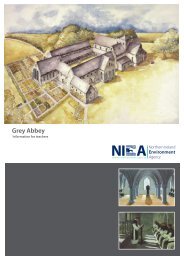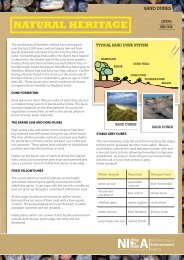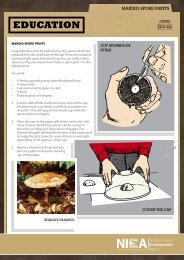Municipal Waste Data Monitoring and Reporting: Interim Guidelines
Municipal Waste Data Monitoring and Reporting: Interim Guidelines
Municipal Waste Data Monitoring and Reporting: Interim Guidelines
You also want an ePaper? Increase the reach of your titles
YUMPU automatically turns print PDFs into web optimized ePapers that Google loves.
eckoned from the beginning of the tax period in which you first start to use a<br />
specified method.<br />
You can use a mixture of specified methods for different waste streams or for<br />
different customers but you must be consistent, that is, when you have started<br />
using a method for a particular waste stream or customer you must continue to do<br />
so.<br />
Method 1 - Maximum permitted weight of container<br />
This involves recording the maximum weight that a lorry, skip, rail wagon, etc. is<br />
permitted to carry <strong>and</strong> applying the appropriate rate of tax. To calculate the weight<br />
of the waste, you should use the gross plated weight of the vehicle/container less<br />
its tare weight. Any vehicles that are partially filled must be treated as full for your<br />
tax calculation purposes. Appendix B of this Notice (see below) details how to apply<br />
the maximum weight method.<br />
To operate this method you must record all waste brought onto your site(s),<br />
showing the identifying number <strong>and</strong> type of vehicle/container, a description of the<br />
waste carried, <strong>and</strong> the date disposed at your site. You must also establish an audit<br />
trail or register which records the gross weight, net tare weight <strong>and</strong> maximum<br />
carrying weight for each vehicle/container using your site(s) for waste disposal.<br />
Method 2 - Volume to weight conversion<br />
To operate this method you will need to know the cubic capacity of the vehicles<br />
(lorry, skip, rail wagon, barge, etc.) that deliver waste to your site <strong>and</strong> these should<br />
be used with the categories of waste <strong>and</strong> the conversion factors in Appendix C (see<br />
below). To comply with Weights <strong>and</strong> Measures legislation the maximum cubic<br />
capacity of the container must be a multiple of 0.1 cubic metres. Measurement can<br />
only go to one decimal place. If the calculation results in a tonnage which is greater<br />
than the legal carrying capacity of the vehicle, it is to your benefit to use the<br />
maximum permitted weight of the container method. Your tax calculations must<br />
be based on all containers <strong>and</strong> vehicles being full.<br />
You must record all waste brought onto your site(s), showing the identifying<br />
number <strong>and</strong> type of vehicle/container, a description of the waste carried, <strong>and</strong> the<br />
date disposed at your site. The volume of the vehicle/container must be recorded<br />
<strong>and</strong> evidenced with whatever documentation is available from the haulier.<br />
Method 3 - Weighing the waste prior to receipt at the site<br />
You may accept waste that is weighed away from your l<strong>and</strong>fill site. If there is a<br />
clear audit trail including a record of weights for each vehicle, container, wagon,<br />
etc. <strong>and</strong> they go directly to the site, then this scheme can be used to calculate<br />
l<strong>and</strong>fill tax.<br />
To operate this method you must record all waste brought onto your site(s),<br />
showing where the waste was weighed, the identifying number <strong>and</strong> type of<br />
vehicle/container, a description of the waste, <strong>and</strong> the date disposed at your site.<br />
You must also record <strong>and</strong> retain the weighbridge tickets<br />
4.4 Discounting water<br />
In certain circumstances, you can apply to discount the water content of waste (but<br />
only where it is not present naturally) when calculating the taxable weight of the<br />
waste. You will need to obtain an application form from the L<strong>and</strong>fill Tax Helpdesk.<br />
If we are satisfied that your application qualifies for a scheme for discounting



